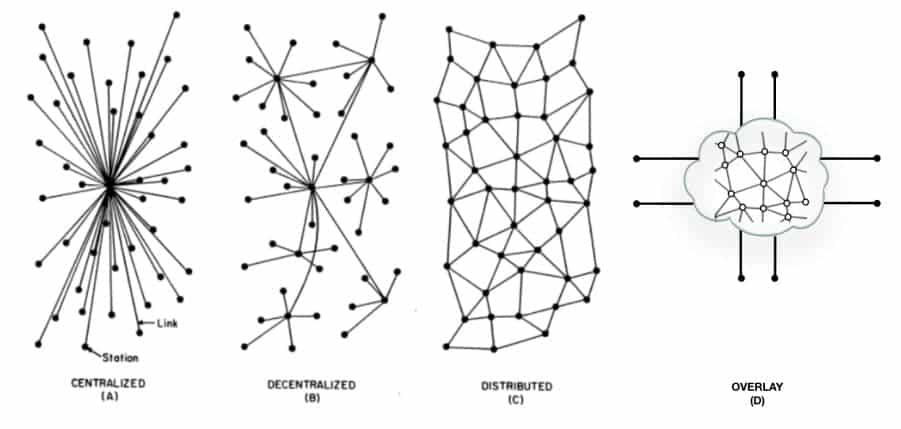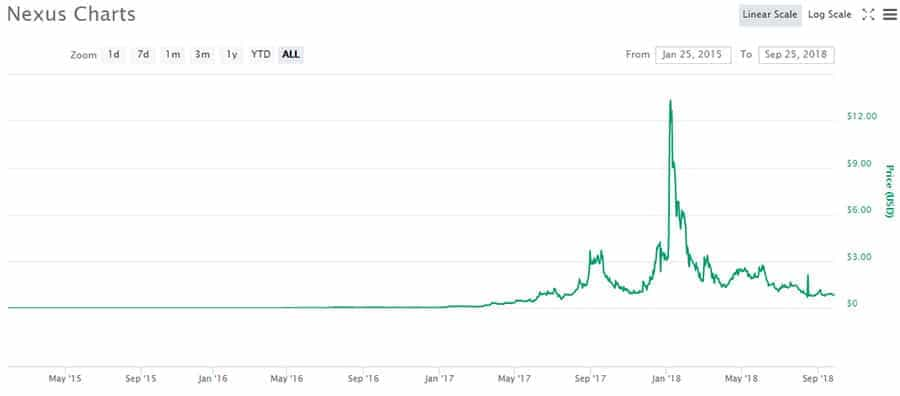Review of Nexus (NXS): Everything You Need to Know
Nexus is another peer-to-peer network that seeks to improve on current blockchain technology by improving the security, scalability and speed of current blockchain protocols.
The project is tackling this in a unique fashion, using a quantum-resistant 3D blockchain together with communication satellites. The ultimate goal is to “decentralize the decentralization” by taking it out of reach of mining pool monopolies or even of any corporate or government control.
If you think this sounds ambitious you’re absolutely right, it is extremely ambitious and could be a game changer if it works out as planned.
Let’s dig in and take a closer look at the technology, history and future plans.
Nexus Three Dimensional Chain (3DC)
Nexus has developed a 3-dimentional blockchain by using three different consensus mechanisms. The team contends that this 3DC works to reduce miner centralization, and will help with more efficiency in on-chain scaling.

The three consensus mechanisms are known as the Prime Channel, the Hashing Channel, and the Proof-of-Holdings Channel.
Prime Channel
The Prime Channel is a Proof-of-Work consensus mechanism that uses 308-digit dense prime clusters. This makes the Prime Channel more ASIC resistant than the usual hash mining. The Prime Channel can be mined using your CPU. Additionally, the mining produces data that is also used for prime number research in quantum physics.
Hashing Channel
This is another Proof-of-Work channel, but it differs because it uses Hashcash as its mining algorithm. This has miners searching for SHA-3 hashes, which is similar to the Bitcoin SHA-256 hashes, but 4 times the size of the Bitcoin block hashes. The Hashing Channel can be mined with a GPU.
Proof-of-Holdings
The final channel is called Proof-of-Holdings and is basically a staking consensus method where users mint new NXS by holding and staking the coins they already have. When using Proof-of-Holdings there are four attributes that determine your rate of return:
- Interest Rate – There is an annual interest rate applied to holdings, which begins at 0.5% annually and increases over 12 months until it reaches the maximum 3.0% annual return.
- Trust Weight – Each node has a trust metric which begins at just 5%, but quickly escalates to 100% in just 1 month’s time.
- Block Weight – This attribute resets to 0% each time you receive a staking transaction. It then slowly climbs to 100% over 24-hours. If your block weight ever reaches 100%, your Trust Key expires and all your attributes reset. The reset trigger ensures that you’re continually working to maintain the network.
- Stake Weight – This is the average of your trust weight and block weight. The higher this value is, the more likely it is you’ll receive a transaction.
Nexus Network Hardware
In order to provide additional decentralization for the network Nexus runs a three tiered telecommunications network. These three tiers are the Mesh Network, the Cube Satellites and the Ground Stations.
Mesh Networks
Nexus is somewhat unique in that almost anyone in the world can run a node thanks to the three different mining opportunities available. It's also unique in that all of the nodes cooperate to solve each block, rather than competing with each other. This allows for a more distributed network.
In addition, Nexus is planning on manufacturing and selling specialized antennas that will allow users to operate local networks.
Cube Satellites
In addition to the ground based mesh network, Nexus is creating a space based satellite network with a group of Low Earth Orbit satellites. This LEO satellite network is being produced in partnership with a company called Vector Space Systems.

These satellites will work in conjunction with the ground network, hosting the Nexus network and any decentralized applications (dApps) that have been built on top of the Nexus network. Additionally, there are plans on providing a global decentralized internet access through the satellite network.
Ground Stations
Finally, there will be a series of ground stations to provide uplink and downlink operations between the ground based and space based networks. The ground stations will also provide address endpoint route defining and ground based caching. They will also be running their own Daemon instance.
Nexus Coin (NXS)
The Nexus coin, denoted NXS, is the currency of the Nexus network. The coin has a current supply of 78 million coins with a 10-year distribution period. After that distribution is complete there will be no cap on the total supply of NXS. Instead, it will inflate at 3% through the holding channel and 1% through the prime and hashing channels.

Blocks are created roughly every 50 seconds, with each NXS transaction requiring 6 network confirmations. Currently transactions have a 0.01 NXS fee, but after the 10-year distribution is complete and the 3DC is completed, there will be no fees as the system will absorb the transaction fees through the inflation mechanism.
Nexus is also somewhat unique in that it never held an ICO. Instead it was designed to take a small developers fee from the mining rewards. That fee is currently 1.5% of the mining rewards, and it will increase to a maximum of 2.5% after 10 years. There is also 20% of the block rewards being put aside for marketing as well as manufacture and launch of the Nexus satellite network.
Nexus Team and Progress
The founder and lead developer of Nexus is Colin Cantrell, who was previously known by the pseudonym 'Videlicet'. When the project was created in September 2014 he called the project Coinshield (CSD). That original code had just one consensus mechanism, the Prime Channel. The Hash Channel was added soon after, in October 2014. The rebrand to Nexus occurred in April 2015 and Proof-of-Holding was added in July 2015.
In addition to having the partnership with Vector to create the satellite network, Nexus has also partnered with SingularityNET to provide the 3DC architecture for the project's decentralized artifical intelligence network.
Moving forward, Nexus is releasing major updates following their TAO (Tritium, Amine, Obsidian) roadmap strategy. The releases include the 3DC, mobile wallets, quantum resistance, and the satellite network, among many other things.

Nexus is arguably the most ambitious project in the cryptocurrency space. First and foremost, the project is attempting to be the first to dethrone Bitcoin as the top peer-to-peer currency. With the decentralized internet that will be produced from its space mesh network of satellites, Nexus is also competing head-to-head with Substratum.
NXS Price and Trading
NXS remained quiet throughout much of its existence, but finally roared to life in 2017 along with most of the crypto-space. Starting at $0.026 in January 2017, the price of NXS rocketed higher, reaching $3.34 by September. It then pulled back to nearly $1.00, but wasn't finished as it soared to an all-time high of $13.33 in January 2018.
The price gains can be attributed in part to the overall bullishness in cryptocurrencies over that time period. The partnership with Vector was also announced during that time, and this also had a positive impact on the price of NXS.

Since hitting the January all-time high, price has dropped significantly as the entire cryptocurrency markets have turned bearish. As of late September, NXS is trading at just $0.85, but this is partially explained by the 50% drop in the value of Bitcoin during the same period.
While the team has released a roadmap, there are no exact dates on the roadmap, so it's pretty impossible to make any predictions as to when we might see price jumps in reaction to positive developments. Like most cryptocurrency projects though, I would expect to see rallies around the release of any important developments.
Where to Buy NXS
NXS can be purchased at Binance or Bittrex, as well as at Trade by Trade, Upbit and Cryptopia. It isn't available in exchange for fiat currency, so you will need BTC, ETH or USDT to purchase your NXS.

It’s also possible to get yourself some NXS by mining. Both your CPU can be used (with Prime Channel) and your GPU (with Hashing Channel). And once you have 1,000 NXS you are able to stake so that you can earn additional coins.
NXS Wallets
There’s an official Nexus wallet that you can get for Windows and Mac on the Nexus website here. It’s also possible to keep your NXS in an exchange wallet, but for security reasons it isn’t recommended. Plus, you can only stake coins if they’re in the official Nexus wallet.
Conclusion
The Nexus blockchain is a new generation type, using three different consensus mechanisms to secure the network, three different mining methods, and three tiers of network hardware to decentralize the network even further.
In addition, one of those tiers is a network of satellites, that will provide free internet access and will remain completely out of the control of any government or corporation. The mission of Nexus is to create a decentralized cryptocurrency that improves on Bitcoin with less miner centralization, lower fees and faster transactions.
Nexus is also one of the few projects that’s tackling the problem of quantum resistance. If this problem becomes as large as some believe it will, Nexus could well be one of the few existing projects still left standing 20 years from now. And that makes it a bargain right now.
Disclaimer: These are the writer’s opinions and should not be considered investment advice. Readers should do their own research.
